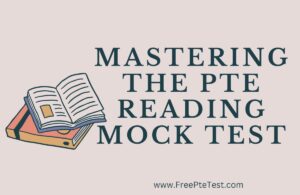Mastering PTE Writing: Paraphrasing is an essential skill in the PTE (Pearson Test of English) writing exam, as it demonstrates your ability to rephrase information while maintaining the original meaning.
It showcases your language proficiency and adds a layer of sophistication to your essay. In this blog, we’ll delve into the art of effective paraphrasing and how it can elevate your essay writing game.
PTE Writing:
1. Grasp the Essence:
Before attempting to paraphrase a passage or idea, ensure you understand the original content thoroughly. Identify the key points, main arguments, and supporting details. This understanding is crucial to preserving the essence of the information when rephrasing it.
2. Replace Synonyms and Change Word Forms:
One of the simplest ways to paraphrase is by substituting words with synonyms. Be cautious, however, as some words may have nuanced meanings. Also, try changing the form of the words, such as converting verbs into nouns or vice versa.
3. Rearrange Sentence Structure:
Another effective technique is to alter the sentence structure. Change the order of the words, clauses, or phrases while maintaining coherence. This not only helps in paraphrasing but also adds variety to your writing.
4. Use Different Sentence Patterns:
Experiment with different sentence patterns to rephrase the same information. For instance, transform a declarative sentence into a question or vice versa. This not only demonstrates your language versatility but also keeps your essay engaging.
5. Change Voice and Perspective:
Switching between active and passive voice, or altering the perspective from third person to first person, can effectively paraphrase a sentence while retaining its meaning. However, ensure the intended meaning remains intact.
6. Combine Sentences and Ideas:
Merge two or more sentences or ideas into one, or split a complex sentence into simpler ones. This technique allows you to convey the same information using different wording.
7. Utilize Advanced Vocabulary:
Incorporating a broader range of vocabulary can make your paraphrasing more sophisticated. However, be cautious not to overdo it, as clarity should always be your priority.
8. Maintain Consistency:
While paraphrasing, maintain consistency in terms of tone, style, and tense. Any abrupt shifts in these elements can lead to confusion and distortion of the original meaning.
9. Cross-Check for Accuracy:
After paraphrasing, cross-check your version with the original to ensure accuracy. The goal is not just to rephrase but to accurately convey the intended message without altering the original author’s intent.
10. Practice, Practice, Practice:
Effective paraphrasing comes with practice. Regularly work on paraphrasing exercises and passages to refine your skills. Over time, you’ll become more adept at rephrasing content while maintaining clarity and accuracy.
11. Mindful Use of Online Tools:
While online paraphrasing tools can be helpful, they should be used with caution. These tools may not always produce accurate results, and blindly relying on them could lead to unintentional plagiarism or awkward phrasing.
Conclusion:
In conclusion, mastering the art of effective paraphrasing is a valuable skill for excelling in the PTE writing exam. It demonstrates your language proficiency, critical thinking, and ability to communicate ideas in various ways.
By understanding the original content, experimenting with different techniques, and practicing consistently, you’ll be well-equipped to craft essays that showcase your prowess in the art of paraphrasing.



